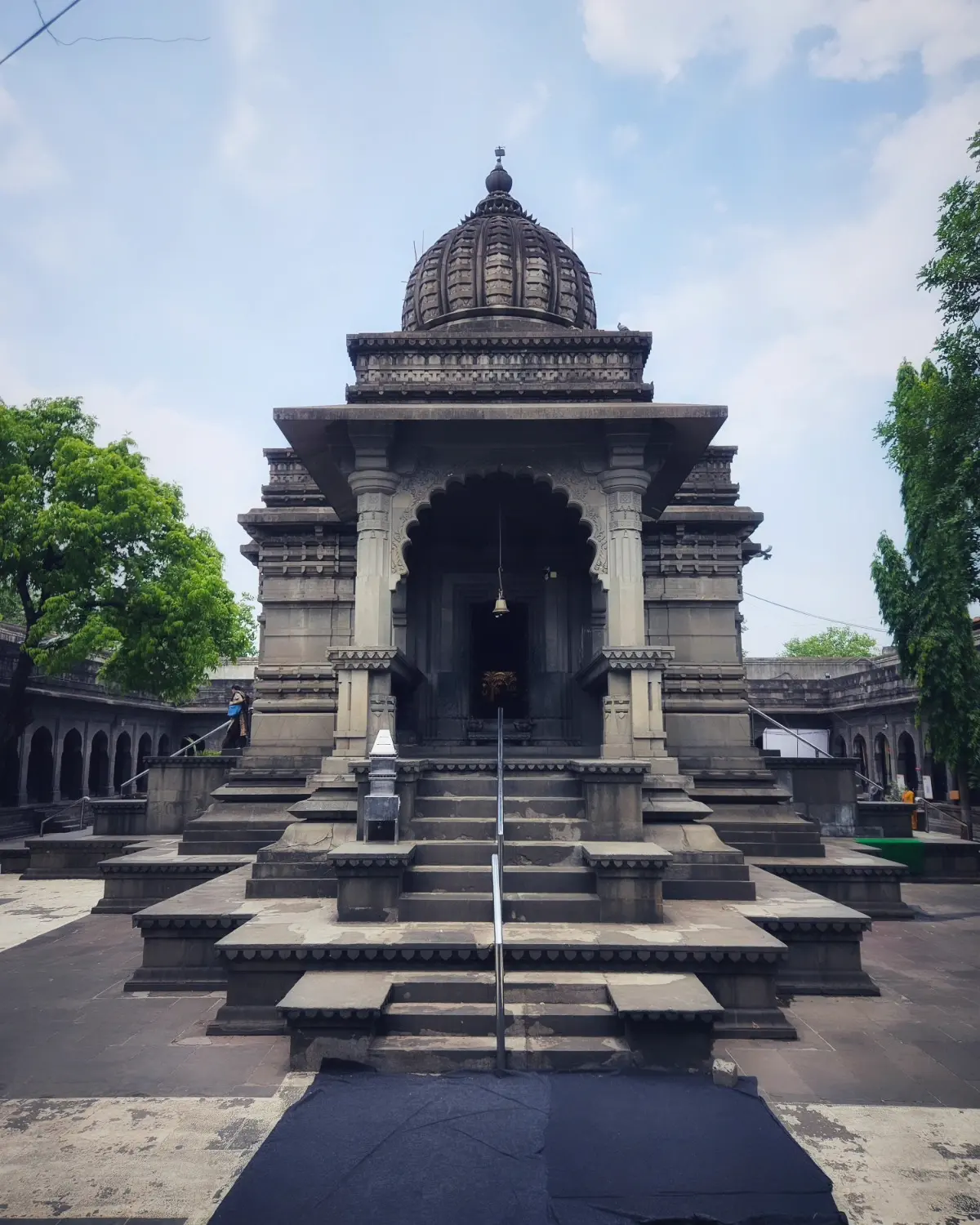Dress Code
Conservative, Traditional
Note
Check rules before clicking any photographs.
Best Time to Visit
Any time is good to visit, but winter (September – February) is preferable.
Shree Kalaram Mandir Sansthan
2Q4W+JXJ, Nirman upavan C-3, Sita Gufaa Rd, opposite Kalaram Temple East door, Panchavati, Nashik, Maharashtra 422003
On 12th January 2024 PM Narendra Modi visited Kalaram Mandir. He also started his 11-day fast that day to mark the beginning of the Ayodhya Ram Mandir inauguration. Moreover, Kalaram Temple is one of the topics of UPSC exams.
This tells us about the special significance Kalaram Mandir holds in Hinduism and in Indian history. And this guide aims to highlight why that is.
Table of Contents
Overview of the Temple
The temple in itself is a marvel. But according to the Panditji (priest) of the temple, there are two unique aspects of Kalaram Mandir:
- The theme of the temple is black. This is something that’s not usually seen in Hindu temples. The statues of Lord Ram, Laxman, Maa Sita & even Mahaveer Hanumanji are in black. Apart from the statues, the temple is also made of black stones.
- The statue of Lord Ram is in Abhayamudra pose. The idol of Lord Ram in other temples is with a ‘Dhanush’ (Bow) in his hands. But in Kalaram Mandir the right hand of Lord Ram is on his chest, in Abhayamudra pose.
Legends & Significance of Kalaram Mandir
- There are 84 artistically carved pillars in the temple. These are said to symbolise the cycle of 84 lakh species a soul must go through before being reborn as a human.
- There are 14 steps to climb to the main temple. These steps represent the 14 years exile of Lord Ram, Laxman & Maa Sita.
- There is a local legend that Lord Ram took a ‘kala’ (black) roop (avatar) to kill the demons in Dandakaranya forest. Thus the name, Kalaram.
- Mahaveer Hanuman is the biggest devotee of Lord Ram. I love how the architect showcased this by designing the temple such that Lord Rama’s idol can be visible from Hanuman’s idol.
- There is a very old tree in the temple. The official website of the temple claims that there is a footprint of Lord Dattatreya under the stone of this tree. Dattatreya is believed to be an incarnation of all three of the trinity gods.
Architectural Design of Kalaram Mandir
The Kalaram Mandir features a 70-foot tall tower made from black stone. The entire temple is surrounded by a 17-foot high black stone wall. Within the walls, the temple complex covers about 70,000 square feet.
And inside the complex, there’s a separate assembly hall where devotees gather. This ensures ample space for the hundreds & thousands of devotees visiting daily.
The Kalaram Mandir is built in the Nagara style. The structure is covered with 32 tons of gold plating. It also has detailed carvings that show scenes from ancient ‘kathas’ (epics), like Ramayana.
There is an idol of Lord Ram, Laxman, Maa Sita & Mahaveer Hanuman in the premises. All of these idols are in black. Outside the temple, there are various small temples of different deities as well. Apart from this there is a statue of the Late Sardar Rangrao Odhekar, the man behind the temple’s construction.
Today, hundreds of thousands of devotees visit it every day to seek the blessings of Lord Ram.
Origin & History of Kalaram Temple
It is believed that the black idol of Lord Ram is around 2000 years old. During the Turkish invasion, the Brahmins sank the idol into the Godavari river to save it. Since then, there was an idol of an unidentified deity (god) in a small temple, where Kalaram Mandir stands today.
In the late 17th century, Sardar Rangrao Odhekar had a divine dream about the location of the black idol. And miraculously, he found the idol of lord Ram in the Godavari river. The place where the idol was found is now called Ram Kund.
This discovery led to the construction of Kalaram Mandir in 1780. Funded by Sardar Rangrao Odhekar, the construction lasted for about 12 years. It took about 2000 workers and 23 Lakh Rupees to build the temple. Also, the stones used in the construction were brought from Ramshej (10 Kms from Nashik).
These statistics might not show the full value of things. But when you consider that these events happened in the 17th century, you can see the deep faith people had in our creator.
Kalaram Mandir Satyagrah

In ancient India there was a huge discrimination against people of lower castes, Dalits. Among many things, the Dalits were denied entry in temples. Many such things led to the formation of anti-caste movement in India. Kalaram Mandir played an important role in this movement.
On 2nd March 1930, Dr. B.R. Ambedkar organised a protest at Kalaram Mandir. This peaceful protest aimed to demand the entry of Dalits into temples. About five thousand Dalits participated, singing songs and raising war cries to demand their right to enter Kalaram Mandir.
The protest was peaceful until April 7, 1930, Ram Navami, the biggest festival at Kalaram Mandir. On that day, a clash broke out between upper-caste & lower-caste people. However, the Dalits remained peaceful on the demand of Dr Ambedkar.
The Kalaram Temple Entry Satyagraha lasted for three years. In the end it didn’t succeed in opening the temple doors to Dalits. Dr. B.R. Ambedkar eventually decided not to continue the movement.
Even though the Satyagraha didn’t succeed in opening the doors to Dalits, it still was an important event. It raised awareness among people & especially the Dalits. The Kalaram mandir Satyagrah marked an important step in the social and political awakening of the Dalits.
Plan your Trip to Kalaram Mandir
A blissful event to attend is the Ram Navami, especially the Rath Yatra of Kalaram Mandir. Marked by thousands of devotees & of positivity, it’s a must-see event.
Temple Schedule
- 5:30 AM to 6:30 AM – Kakad Aarti
- 7:00 AM to 8:00 AM – Sanai Vadan & Bhupali
- 8:00 AM to 10:00 AM – Mangal Aarti of Lord Rama
- 10:30 AM to 1:00 PM – Mahanyas Pooja of Lord Rama & Maha Aarti
- 3:00 PM to 5:00 PM – Vividh Bhajani Mandal Performs Bhajans
- 7:00 PM to 8:00 PM – Shej Aarti of Lord Rama
- 8:00 PM to 10:00 PM – Kirtan
Check the latest information before visiting, as hours may change due to events or maintenance. Confirm by contacting the tourism board or checking the official website.
For more information, check out our post on all the temples in Nashik.


